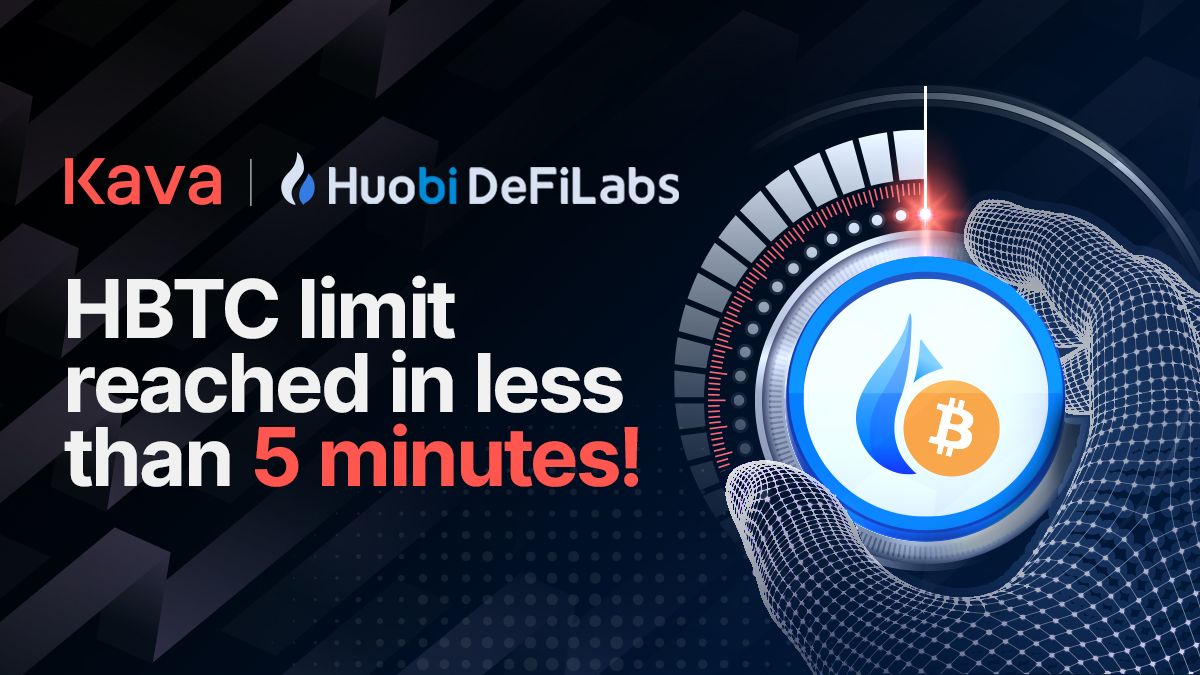Huobi’s Integration Of Kava Sells Out In Under Five Minutes

HBTC, the native tokenized Bitcoin asset of Huobi, is now compatible with hidden DeFi gem Kava. A partnership between Huobi DeFi Labs and Kava Labs brings a new earning opportunity to this asset. Exchange users can stake HBTC to begin earning their 8% annual yield.

Earning Yield With HBTC
Huobi launched HBTC in February 2020 as a pegged asset to Bitcoin. The purpose of this asset is to explore opportunities on the Ethereum network, including decentralized finance. As of March 11, a new use case has been added for HBTC with Kava Labs’ help: token holders can now stake HBTC to earn an 8% yield until March 12, 2022.
The launch of HBTC staking marks an important milestone for the strategic collaboration between Huobi DeFi Labs and Kava Labs. Both entities have been working together since December of 2019, allowing them to combine their powerful resources to create an encompassing CeFi and DeFi solution capable of meeting diversified market needs.
The industry leadership of Huobi and Kava’s success in the decentralized finance sector creates a powerful combination. Kava has successfully integrated major centralized finance institutions into DeFi, bringing a lot more exposure and interest to this growing industry.
On the path to bringing more users to decentralized finance by offering a smoother experience, the HBTC integration is crucial. As HBTC users can obtain a high APY of up to 8% with a total limit of up to 500 HBTC, it is a compelling offer to check out. To allow for this opportunity, Kava has added HBTC to its DeFi platform following a successful governance proposal in February. Moreover, the team aims to distribute 2.5 million KAVA as minting incentives to users annually.
It is also worth noting that creating HBTC on Kava ensures the asset is viable as collateral for USDX loans in Kava’s lending app. Going one step further, holders can supply HBTC in the HARD Protocol Money Markets to borrow, lend, and earn.
Pushing DeFi Adoption Forward
In the world of decentralized finance, it is crucial to acquire new users and tap into additional liquidity. Direct integration of Huobi onto Kava highlights this industry’s potential for combining centralized and decentralized aspects into one. It is pertinent to create solutions and services that people can trust.
Although DeFi is still in the early days of development, it is crucial to provide a sustainable future foundation. Currently, users prefer a diversified approach for decentralized finance products. Catering to this demand forces service providers to develop innovative products and services to gain a dominant market position.
The staking of HBTC is a crucial example of combining the best of CeFi with DeFi. Unlike other staking products, this new offering has unlimited potential with a single integration. Bringing broader access to DeFi products without leaving the trusted Huobi environment offers a much better overall user experience.
Kava Labs CEO Brian Kerr comments:
“With Huobi DeFi Labs integrating Kava’s DeFi applications and services, Huobi users around the world can access to DeFi earning opportunities in just a few clicks, finally making DeFi accessible to a mainstream audience. This has the potential to bring millions of new users to Kava’s platform and enables them with the ability to generate superior returns passively with their Bitcoin and soon other digital assets.”
For Kava, maintaining and leveraging its dominant position as a decentralized finance infrastructure provider allows it to bring lending and borrowing incentives to more platforms. As more centralized exchanges acknowledge the potential, this DeFi platform has, their reach is likely to keep growing. Providing the highest DeFi earning experience on a CeFi platform is just one example of what such integrations can entail.
Conclusion
Following this news, the Huobi integration sold out in under five minutes, confirming the growing demand for such solutions. Moreover, the Kava price managed to push to $7, as holders see the benefit of cooperation between decentralized finance protocols and centralized exchanges.
When centralized exchanges work together with DeFi teams, exciting things can happen in the future. These industries are not mutually exclusive yet can significantly strengthen one another’s appeal. Cooperation in this industry is vital to not only remain competitive but to empower users as well. Rather than opposing new ideas and concepts, the time is now to experiment with different options.
Check our guide of the most promising crypto




